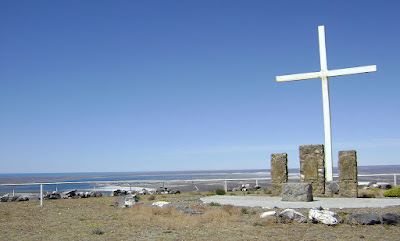 |
| Juan de Cartagena |
When Spain’s newly crowned King Carlos I (Charles V) agreed to back Magellan’s expedition, several Castilian officials at Valladolid set out to undermine the project. They did not want a Portuguese fleet commander for such an expedition. (Carlos was an 18-year-old from Flanders working partially with Flemish advisers.)
The day the Articles of Agreement were signed, a royal decree was also inked naming Cartagena as inspector-general of the fleet, a check on Magellan’s power. Cartagena was a confidant and “nephew” (possibly illegitimate son) of Archbishop Juan Rodríguez de Fonseca, a relationship other officers in the armada knew of and one that Magellan was forced to respect, to a degree.
Once at sea, Cartagena openly defied Magellan’s authority, driving the captain-general to arrest him before they even crossed the Atlantic. Still a captive when the fleet reached Patagonia, Cartagena broke loose and returned to the San Antonio to lead a mutiny.
Cartagena joined the Concepción's Captain Gaspar de Quesada, its pilot, Juan Sebastián Elcano, and 30 Spanish crew members to seize control of the vessel. Quickly the mutiny pitted three ships—the San Antonio, the Concepción, and the Victoria—against Magellan’s flagship Trinidad and the Santiago.
Although outnumbered, Magellan quickly prevailed in a battle at sea that included sending Duarte Barbosa to board the Victoria and retake it by force, a decisive surprise attack.
Magellan convened a court martial onshore at Puerto San Julian. Quesada was sentenced to death by beheading (and quartering afterward). Cartagena was spared the beheading, likely because of his relationship to Archbishop Fonseca. He was sentenced instead to be marooned along with a priest, Pedro Sánchez de la Reina, who was among the mutineers.
On August 11, 1520, Juan de Cartagena and Reina were left marooned on a small island off Puerto San Julian with a small supply of sea biscuit and wine—this along a coastline where the fleet had already encountered cannibals and Patagonian “giants.”
 |
| Hill of Monte Cristo, where Magellan had a cross installed before departing Puerto San Julian on 08/21/1520. |
Later at the entrance of the strait, two other officers aboard the San Antonio mutinied again, putting the replacement captain, Álvaro de Mesquita, in chains. (Mesquita was a nephew of Magellan.)
They piloted out of the strait and sailed directly back to Spain [2] without stopping to replenish supplies or rescue Cartagena and Reina, who were never seen or heard from again.
By John Sailors
[2] Note to self: Stop writing “the Victoria was the only ship of the fleet to return to Spain.” The San Antonio did too, just in disgrace via mutiny and without circumnavigating the globe.
Monte Cristo: De Fernando de Gorocica - Trabajo propio, CC BY-SA 3.0, commons. wikimedia.org/w/index.php?curid=32923586.
(C) 2022, by John Sailors.
Enrique's Voyage Profiles
Magellan's Real Circumnavigation, Enrique of Malacca Taken as Slave (Magellan, Part 1)
Schoolchildren around the world are taught the name Ferdinand Magellan[1]—“the first person to circumnavigate the globe”—many in grade school and again high school. But few people know Magellan's story, that he was killed in the Philippines halfway through that circumnavigation, and moreover, that he still came within 2,600 kilometers of fully circling the earth. Read more.
Spain's King Charles named Magellan captain-general of the Armada de Molucca, but from the start he had to enforce his authority with an iron hand. In Asia a decade earlier Magellan had been more soldier than sailor. Now as commander of a naval fleet, Magellan relied on his military fleet background to maintain control of his own armada. Read more.
Holy Roman Emperor Charles V Backs Magellan's Armada
Ferdinand Magellan’s Armada de Molucca was financed by Carlos I (1500–1558), the newly crowned king of a unified Castile and Aragon. Carlos was an eighteen-year-old Habsburg from Flanders who barely spoke Spanish. Between the time he agreed to back Magellan's expedition and its departure, he became Charles V, Holy Roman emperor, and archduke of Austria. Read More.
Juan de Cartagena Leads Mutiny Against Magellan
Juan de Cartagena, a native of Burgos, was the original captain of the San Antonio and one of the human obstacles Ferdinand Magellan had to overcome on the expedition. History labels Magellan and Columbus and other ship captains as “explorers” and “navigators.” Cartagena is identified as “an accountant and a ship captain” [1], not quite the swashbuckling image that inspires fifth graders in history class. Read more.
Frequently Asked Questions
• Who was Enrique of Malacca? (History/Biography)
• What was Enrique of Malacca’s Real Name
• What was Enrique of Malacca’s Cause of Death?
• Was Enrique First to Circumnavigate the Earth?
• Where was Enrique of Malacca from?
• Was Enrique of Malacca Filipino?
- EnriqueOfMalacca.com
- Enrique of Malacca on Twitter
- Enrique of Malacca on Facebook
- John Sailors / Enrique on Medium
- And, yes, Enrique might be 500 years old, but he was known as a kid, so of course he's now on Instagram too.
